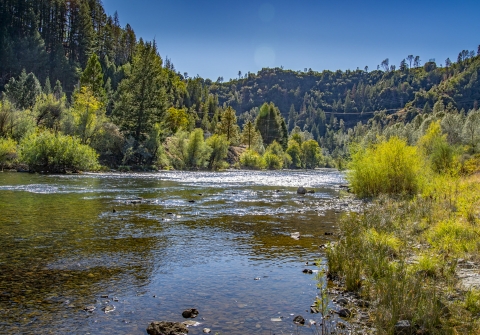After seven years of robust discussion and collaboration, the U.S. Fish and Wildlife Service finalized the Klamath Basin Integrated Fisheries Restoration and Monitoring Plan, which will serve as a living roadmap describing the highest priority watershed restoration and monitoring actions to help reverse the declines of multiple native Klamath Basin fish populations and ecosystems and communities.
The Klamath Integrated Fish Plan will help guide and complement existing restoration efforts in the basin. The plan was developed in partnership with the Pacific States Marine Fisheries Commission and ESSA Technologies, with extensive input from over 100 participants from academic, government, Tribal and nongovernmental organizations.
“Impacts to native fish have been deeply felt by many who live, work and fish across the Klamath Basin,” said Service Regional Director Paul Souza. “This plan builds on existing conservation efforts in the basin and provides a unifying framework for coordinated restoration and recovery of native fish species from the headwaters to the Pacific Ocean, while improving flows, water quality, habitat and ecosystem processes to benefit local communities.”
Focal fish species include Chinook and coho salmon, steelhead, bull trout, redband trout, Pacific lamprey, Lost River sucker (C’waam), shortnose sucker (Koptu), green sturgeon and eulachon.
Restoration actions identified in the plan include improving fish passage fish passage
Fish passage is the ability of fish or other aquatic species to move freely throughout their life to find food, reproduce, and complete their natural migration cycles. Millions of barriers to fish passage across the country are fragmenting habitat and leading to species declines. The U.S. Fish and Wildlife Service's National Fish Passage Program is working to reconnect watersheds to benefit both wildlife and people.
Learn more about fish passage at Keno Dam, working with willing sellers to acquire water rights to improve water flows, working with producers to improve riparian riparian
Definition of riparian habitat or riparian areas.
Learn more about riparian vegetation and water quality, and restoring water channels and floodplains to improve spawning habitat.
“NOAA Fisheries is one of many partners invested in building a network of restored habitats that can support fish species once the dams are removed,” said Scott Rumsey, Acting Regional Administrator in NOAA Fisheries’ West Coast Region. “With dam removal in our sights, restoration of historically inaccessible habitat is now more important than ever.”
The integrated fish plan addresses a long-standing recommendation of the National Research Council to better integrate and close gaps by standardizing the way functional ecosystem and habitat restoration is approached in the Klamath Basin.
The plan is made up of several components including:
Over 140 priority restoration concepts across 12 subbasins to be implemented over many years.
Strategies for closing monitoring gaps for important indicators of fish and watershed health across the basin.
Cost estimates for restoration and monitoring priorities.
A dynamic restoration action prioritization tool to help organize information and data needed to iteratively update lists of priority restoration projects in the future.
Adaptively updating restoration priorities and plan implementation based on current conditions.
Additionally, the plan is accompanied by a condensed Restoration Action Agenda for 2023-2024, outlining several of the highest priority restoration projects in each subbasin. These shorter-term priorities are drawn from the plan’s larger list of 140 restoration actions based on actions planning partners considered to be the most important for implementation.
This resource is available for use by all partners and stakeholders engaging in fisheries restoration. It is one of several tools that can help inform those preparing proposals for Klamath Bipartisan Infrastructure Law Bipartisan Infrastructure Law
The Bipartisan Infrastructure Law (BIL) is a once-in-a-generation investment in the nation’s infrastructure and economic competitiveness. We were directly appropriated $455 million over five years in BIL funds for programs related to the President’s America the Beautiful initiative.
Learn more about Bipartisan Infrastructure Law funding or other competitive grant programs in the basin.
The integrated fish plan and shorter-term Restoration Action Agenda are intended to be updated on a regular basis as work is completed and new ideas and information are brought forward through ongoing monitoring, research, and restoration implementation.





